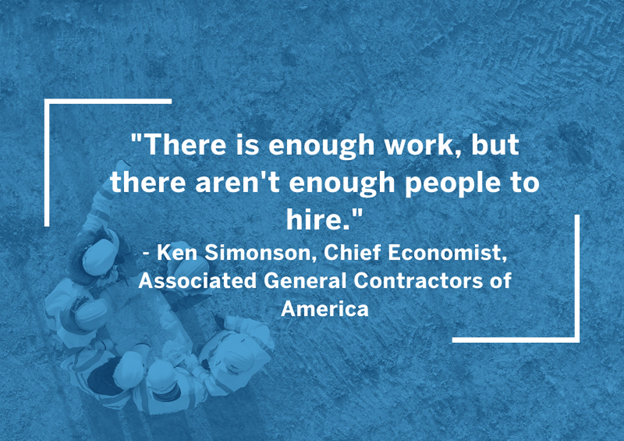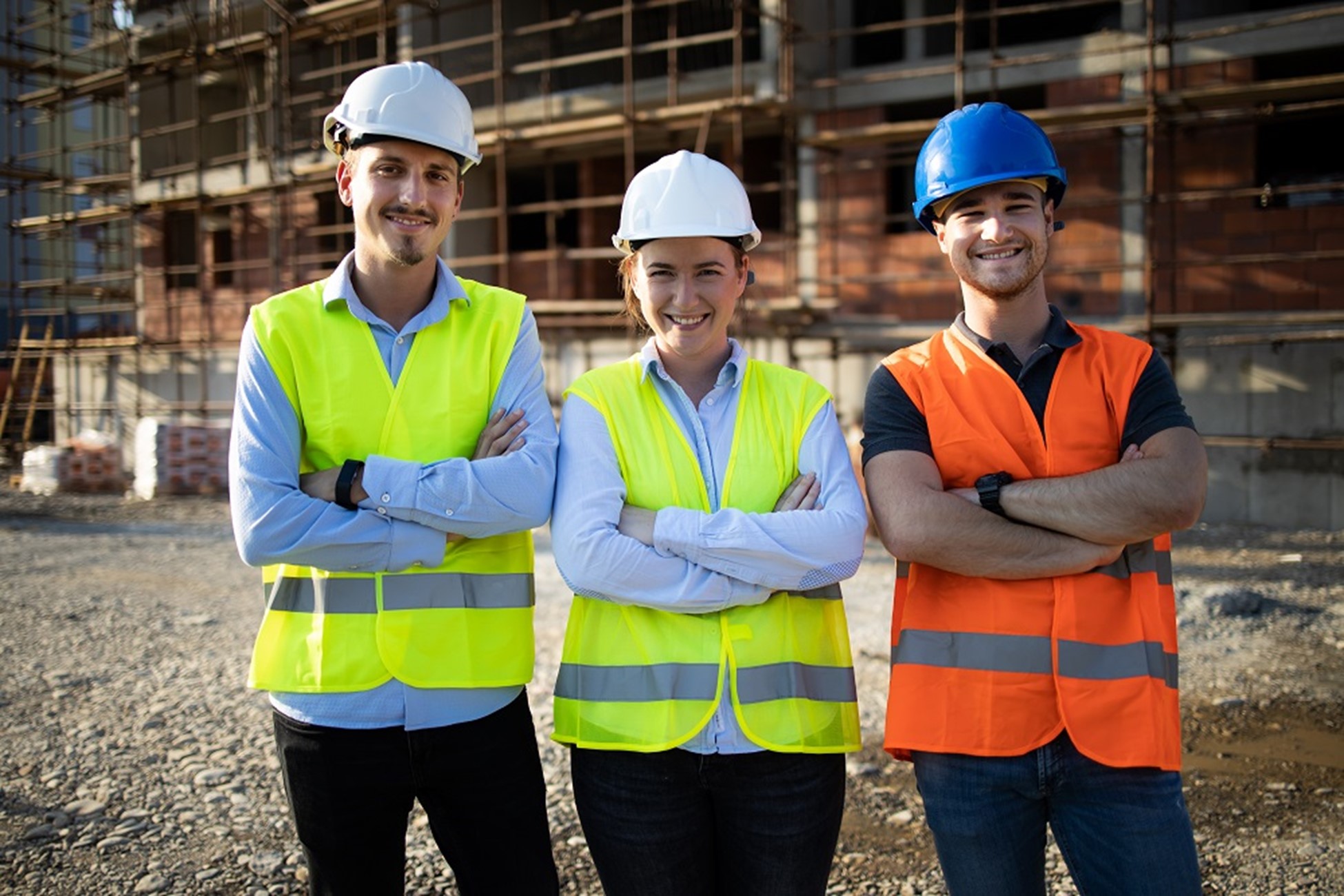- According to a National Association of Home Builders report, construction needs 2.2 million new hires from 2022-2024 to keep up with industry growth and the loss of workers through retirement or exiting the sector.
- That's 61,000 new hires every month!
- Employers will need to pull out all the stops when it comes to bringing in new workers and getting them to stay.
- Since we know that younger generations want different things from work than their parents did, we decided to ask: Will firms who use the design-build project delivery method actually have an easier time recruiting and developing people than more traditional design-bid-build firms?
Do Design-Build Firms Have an Edge When It Comes to Recruiting and Retaining Talent?
Labor shortages in construction have entered crisis mode
The inability to recruit and retain top talent has been felt across every sector during this unprecedented labor shortage, and the construction industry is no exception. There is no shortage of available work, with construction spending on the rise and an influx of projects expected due to funding from the recently passed infrastructure bill, but staffing those projects is another story.

With 41 percent of the current US construction workforce expected to retire by 2031, the problem is not positioned to go away any time soon. Companies are competing against each other to reach a very limited talent pool. To widen this talent pool and pique the interest of qualified young professionals, the construction industry might consider leveraging tools already in the toolkit.
What will it take to bring in younger workers?
As younger generations enter the workforce, they are demanding a new set of workplace standards that will keep them fulfilled in their day-to-day and satisfied in the long-term. What does it take to get the top talent of the younger generation to come on board and stick around? Open and honest communication, positive core values, and professional connections top the list—all features of the design-build delivery method.
The design-build difference
What is design-build
The design-build delivery method puts the designer and the builder on the same team. Rather than the design firm and the construction manager having separate contracts with the project owner, and naturally separate goals, design-build uses a single contract with each party working together towards aligned objectives.
Design-build projects currently make up 42% of the total U.S. construction put-in-place spending with that figure expected to climb to 47% by 2025, according to the Design-Build Institute of America.
What does design-build mean for workers?
With a traditional project delivery, or design-bid-build, “contractors’ priorities tend to be budget and schedule, and your interior designer is more concerned with the aesthetic … Your architect is concerned with making sure that the function of your building is providing the client with a product that services them in the best way possible,” explains Rebecca Wilcox, a project manager with Neenan Archistruction. “...because those goals are so different, you have a lot of friction because those entities aren’t working together.”
A unified front is formed with a design-build project. The team works together in a collaborative way to manage the project and produce the best outcome for all parties. While advantages such as reducing costs and staying on schedule are often highlighted, social and cultural advantages should not be overlooked as a powerful differentiator.
Rebecca Wilcox, project manager at Neenan Archistruction, explains why she loves working at a design-build firm.
What younger generations want from a workplace
Generation Z, those born between 1997 and 2012, and Millennials, those born between 1981 and 1996, now account for almost half (46%) of the U.S. workforce, according to Gallup. As these generations enter the workforce and rise into leadership roles, they have demonstrated what it takes to keep them happy and fulfilled in their career. Their workplace expectations have also been shaped by the recent pandemic. A few of the more prominent preferences include:
Flexibility & Work-Life Balance
More flexibility from employers is a highly sought-after request for many seeking new employment opportunities this year, including among Gen Z and Millennials. A recent survey by GOBankingRates found that 42% of Gen Z workers highlighted work-life balance, working-from-home, and flexibility as their top priorities over other perks when searching for a new job.
Value-Driven, Ethical Work
This younger generation desires meaning and fulfillment in their day-to-day work—seeking out jobs that align with their values. A global survey conducted by Deloitte found that 49% of Gen Zs and 44% of Millennials made a decision about their career path and potential employers based on their personal ethics. For them, a job is about more than just where you spend your time or who you receive a paycheck from—it becomes a part of who you are.
Face-to-Face Communication & Collaboration
A generation that grew up in the digital age with the internet always at their fingertips, you may assume would prefer digital communication, but according to a poll conducted by Millennial and Gen Z expert Ryan Jenkins, 72% of Gen Zs prefer face-to-face communication at work. Additionally, the Defense Contract Audit Agency explains that Generation Z prefers collaborative environments that allow brainstorming and connecting with team members.
Professional Networking
The impact of networking is not lost on this generation. While Gen Z may place a greater emphasis on digital platforms for building professional relationships, they still understand the importance of networking in career progression and industry involvement. Young professionals also feel the need to make up for a deficit in their professional networks brought on by the recent pandemic.
Is there a connection between the design-build delivery method and what younger generations want in their career?
A design-build project clearly promotes more of the workplace ideology Gen Z and Millennials prefer when compared to traditional project delivery methods. While preferences such as work-life balance and flexibility are more likely to find a place within the culture of a company, values, collaboration, and networking are all essential functions of a successful design-build project.
During projects where each party is separately contracted and has their own set of goals, it is

not uncommon for contractors to blame issues on designers and vice versa. These circumstances can often nurture a culture that feels hostile, leading to project delays or even future litigation. Design-build collaborative delivery eliminates these adversarial conditions. The Design-Build Institute of America believes that “design-build is intended to be a highly collaborative, fully integrated process that is built on trust, mutual respect, [and] teamwork,” per their Design-Build Done Right® primer. Working as a singular group promotes a more ethical environment that could appeal to the type of value-based work Gen Zs and Millennials are looking for.
Putting architects, contractors, designers, and quality controllers all on the same team is the perfect recipe for effective brainstorming and creative problem-solving. It benefits everyone to have transparent conversations and bring the best ideas to the table. As Rebecca Wilcox of Neenan Archistruction describes it, “…you have to come to design-build with a certain amount of humility and open-mindedness to be able to really meet people where they are and to be able to respect and appreciate what it is that they do and what they bring to the table.” The younger generation is likely to find great satisfaction in the collaborative, considerate environment design-build creates.
The same collaboration inherent in design-build that promotes open communication lays the framework for professional networking opportunities. Individuals who work on a design-build project are likely to form lifelong connections with their cross-industry counterparts that will serve them throughout their entire career. This networking is especially important for young professionals looking to plant roots and feel integrated within their field. Creating these connections for those just entering the workforce is important for retention; young professionals feel part of a cohort that enables learning and growing alongside one another as their careers progress.
Is design-build the changemaker construction recruiting needs?
87 percent of construction leaders believe skilled labor shortages will have the greatest impact on the industry in the years to come. The construction industry must recognize this

imminent laborforce issue and adapt accordingly to mitigate the impact. It is apparent that large-scale changes need to take place in the industry to appeal to younger and more diverse talent, however, a refreshed focus on design-build projects could be a good starting point.
Firms adopting the design-build delivery method, coupled with other organizational and cultural changes, could attract more talent of the younger generation and allow them to build successful lifelong careers in the construction industry that align with their values and preferences. The benefits of design-build, outside of simply time and cost savings, should be honed by project teams and highlighted across the industry as an effective recruitment tool.






